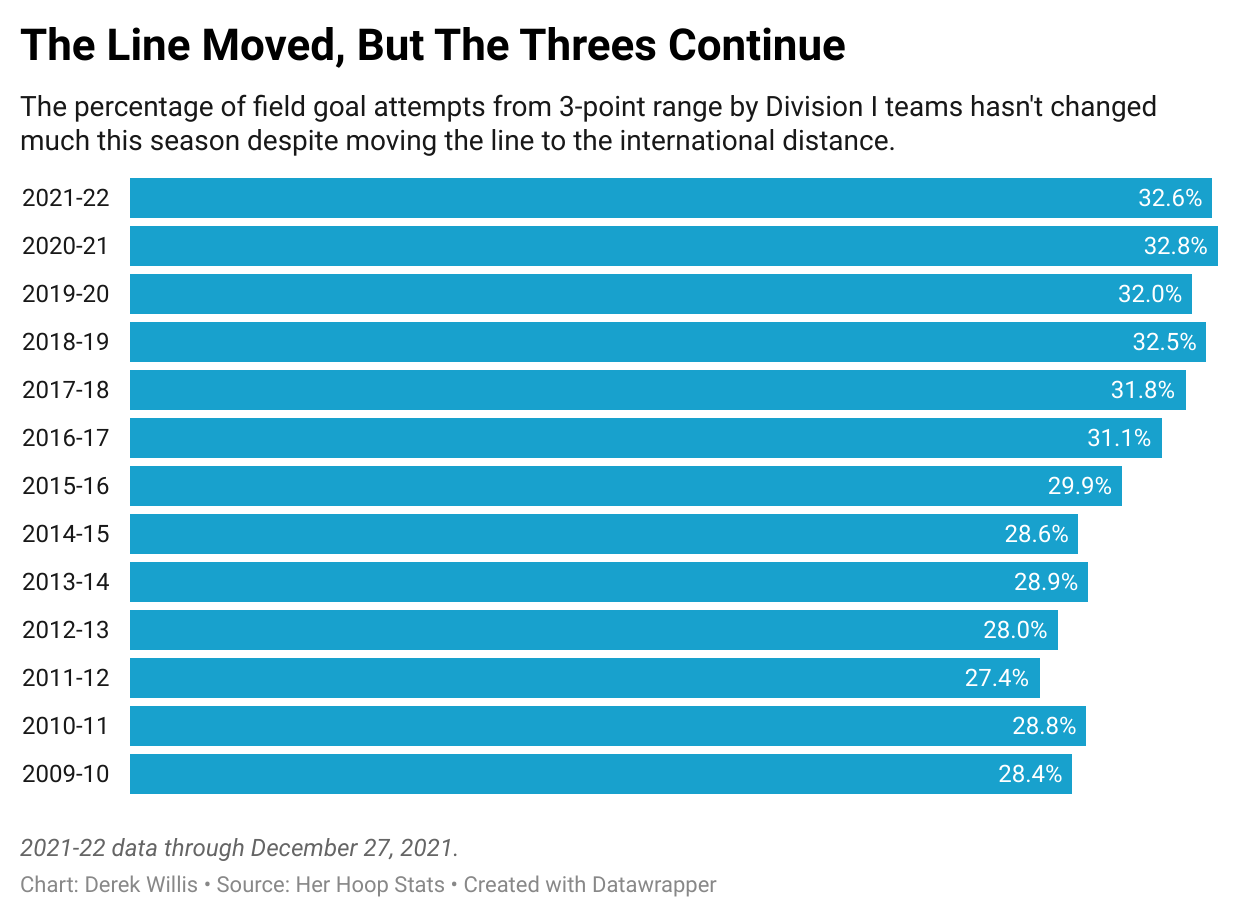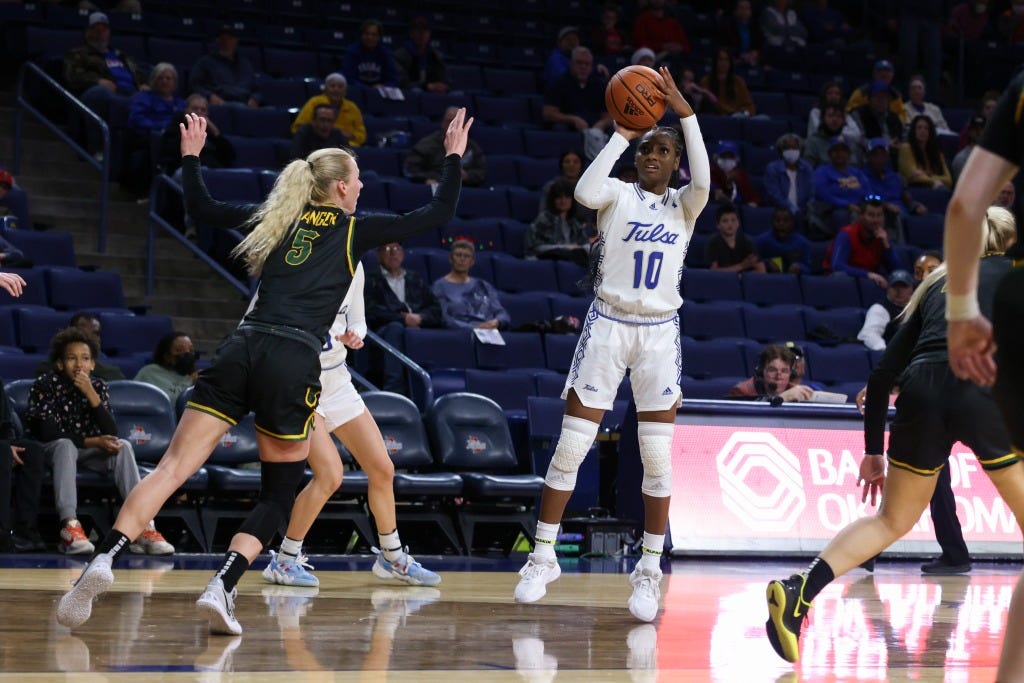The Rain of Threes Continues
Teams continue to rely on 3-pointers despite the longer distance this year
Thanks for reading the Her Hoop Stats Newsletter. If you like our work, be sure to check out our stats site, our podcast, and our social media accounts on Twitter, YouTube, Facebook, and Instagram. You can also buy Her Hoop Stats gear, such as laptop stickers, mugs, and shirts!
Haven’t subscribed to the Her Hoop Stats Newsletter yet?
When the NCAA moved the three-point line to the international distance of 22 feet, 1¾ inches before the start of this season, the natural question was how teams would react.
Based on the early season results, teams have kept on shooting 3-pointers, continuing the trend of the past decade. Through December 27, the percentage of shots by Division I teams that have come from 3-point range this season is 32.6%, down very slightly from the abbreviated 2020-21 season but higher than in other previous years.
While they are taking as many as threes as ever, teams are not making quite as many this year. The overall 3-point percentage this season is 30.7%, the lowest it has been since 2012-13, but still not far off from the relatively small range of 30.6-31.9% since the 2009-10 season. Granted, this season is far from over, and this year’s percentage is likely to change at least a little.
What you don’t see in the overall data, however, are dramatic improvements in 3-point shooting by some teams. Take Tulsa, which at 10-1 is off to its best start since the 2005-06 season, when it finished 28-6 and beat NC State in the first round of the NCAA Tournament.
Tulsa is a vastly better shooting team than it was even two years ago, the last apples-to-apples comparison. During the 2019-2020 season, the Golden Hurricane ranked 307th among Division I teams in 3-point percentage, hitting 27.7% of its long range shots. In a shortened 2020-21 campaign, Tulsa ranked 228th in 3-point percentage. This year, Tulsa has the second-best 3-point shooting percentage among Division I teams, hitting 42.8% of its shots against Division I opponents.
Playing under Angie Nelp, in her first year as the head coach, the team has increased its shooting percentage in every category, including free throws.
The long-range success isn’t because the Golden Hurricane are taking fewer threes, either: they average about 21 attempts a game through the first 11 contests, the highest rate they’ve had in the time that Her Hoop Stats has been tracking statistics (2009-10).
Six players have made at least 10 3-pointers for Tulsa this season, led by senior Maya Mayberry, who averages 15.7 points a game and has made more than half of her shots from beyond the arc. Her sister, sophomore Wyvette Mayberry, is hitting 46% from long-range. Their father is former NBA player Lee Mayberry, who was a career 42% shooter from distance during his college career at Arkansas. Last season, the sisters accounted for 46% of Tulsa’s scoring; this season, that’s down to 35% as other players are contributing.
Tulsa typically starts four guards and a forward, but just one player who plays heavy minutes, fifth-year senior guard Rebecca Lescay, has not attempted a 3-pointer this season. That fits a pattern; Lescay has made just three threes in her college career.
Tulsa isn’t the only team that has dramatically improved its 3-point shooting this season compared to two years ago. Notre Dame and Texas A&M also have seen big increases in their shooting percentages, along with Nebraska and Ohio State. In many cases one player can make a big difference. Transfers Jaz Shelley and Taylor Mikesell are hitting more than half of their 3-point shots for the Cornhuskers and Buckeyes, respectively. Kayla Wells of Texas A&M also has come out of the gate hot, hitting 56% of her shots beyond the arc.
After an abysmal 3-point performance last season, California has rebounded in a big way from beyond the arc. The Golden Bears made just 21% of their 3-point attempts in the 17 games they played in 2020-21. This season, led by freshman Jayda Curry and junior Jazlen Green, they are hitting 34.6% of their long-range shots.
To balance out significant improvements, there are some notable teams who have struggled from 3-point distance this year. Among them is UConn. In nine games, the Huskies have made 31.8% of their shots from beyond the arc, which many teams would happily take. But that’s a drop-off for UConn, which hasn’t made less than 35% of its 3-pointers in a season since 2009-10 (the absences of Paige Bueckers and Azzi Fudd due to injury aren’t likely to help in the immediate future, either).
Maryland and Iowa, two other high-flying offenses that shot 40% from long range last season, are off that pace so far this season as well. Iowa is making 30% of its threes, which, if it held up, would be the lowest since at least 2009-10. Chances are it doesn’t hold up, since Caitlin Clark, who shoots the most threes on the team, is currently hitting just 25% of them. Oklahoma State, which has been an inconsistent long-range shooting team in recent years, has hit just 23% of its 3-point shots in nine games this season.
Shooting form is a fickle thing, and it’s not certain that the early-season trends will continue, especially for individual teams. However, it does seem clear that moving the line hasn’t reduced the importance of the 3-point shot or the willingness of teams to take it.
Thanks for reading the Her Hoop Stats Newsletter. If you like our work, be sure to check out our stats site, our podcast, and our social media accounts on Twitter, YouTube, Facebook, and Instagram.






